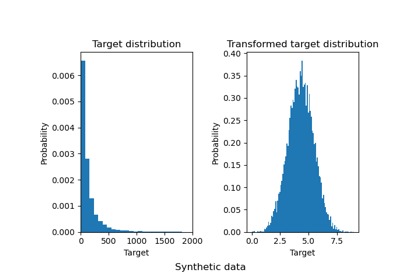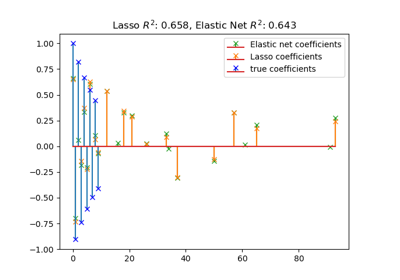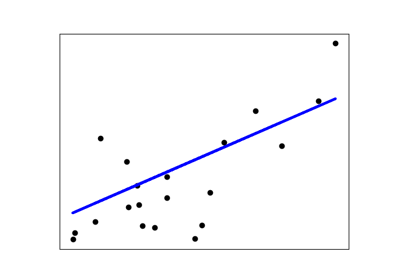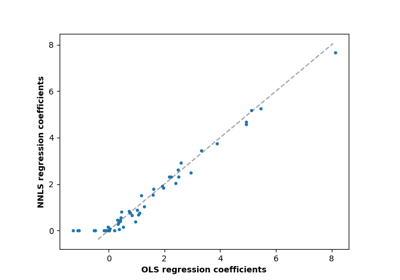sklearn.metrics.r2_score¶
- sklearn.metrics.r2_score(y_true, y_pred, *, sample_weight=None, multioutput='uniform_average', force_finite=True)[source]¶
\(R^2\) (coefficient of determination) regression score function.
Best possible score is 1.0 and it can be negative (because the model can be arbitrarily worse). In the general case when the true y is non-constant, a constant model that always predicts the average y disregarding the input features would get a \(R^2\) score of 0.0.
In the particular case when
y_trueis constant, the \(R^2\) score is not finite: it is eitherNaN(perfect predictions) or-Inf(imperfect predictions). To prevent such non-finite numbers to pollute higher-level experiments such as a grid search cross-validation, by default these cases are replaced with 1.0 (perfect predictions) or 0.0 (imperfect predictions) respectively. You can setforce_finitetoFalseto prevent this fix from happening.Note: when the prediction residuals have zero mean, the \(R^2\) score is identical to the
Explained Variance score.Read more in the User Guide.
- Parameters:
- y_truearray-like of shape (n_samples,) or (n_samples, n_outputs)
Ground truth (correct) target values.
- y_predarray-like of shape (n_samples,) or (n_samples, n_outputs)
Estimated target values.
- sample_weightarray-like of shape (n_samples,), default=None
Sample weights.
- multioutput{‘raw_values’, ‘uniform_average’, ‘variance_weighted’}, array-like of shape (n_outputs,) or None, default=’uniform_average’
Defines aggregating of multiple output scores. Array-like value defines weights used to average scores. Default is “uniform_average”.
- ‘raw_values’ :
Returns a full set of scores in case of multioutput input.
- ‘uniform_average’ :
Scores of all outputs are averaged with uniform weight.
- ‘variance_weighted’ :
Scores of all outputs are averaged, weighted by the variances of each individual output.
Changed in version 0.19: Default value of multioutput is ‘uniform_average’.
- force_finitebool, default=True
Flag indicating if
NaNand-Infscores resulting from constant data should be replaced with real numbers (1.0if prediction is perfect,0.0otherwise). Default isTrue, a convenient setting for hyperparameters’ search procedures (e.g. grid search cross-validation).New in version 1.1.
- Returns:
- zfloat or ndarray of floats
The \(R^2\) score or ndarray of scores if ‘multioutput’ is ‘raw_values’.
Notes
This is not a symmetric function.
Unlike most other scores, \(R^2\) score may be negative (it need not actually be the square of a quantity R).
This metric is not well-defined for single samples and will return a NaN value if n_samples is less than two.
References
Examples
>>> from sklearn.metrics import r2_score >>> y_true = [3, -0.5, 2, 7] >>> y_pred = [2.5, 0.0, 2, 8] >>> r2_score(y_true, y_pred) 0.948... >>> y_true = [[0.5, 1], [-1, 1], [7, -6]] >>> y_pred = [[0, 2], [-1, 2], [8, -5]] >>> r2_score(y_true, y_pred, ... multioutput='variance_weighted') 0.938... >>> y_true = [1, 2, 3] >>> y_pred = [1, 2, 3] >>> r2_score(y_true, y_pred) 1.0 >>> y_true = [1, 2, 3] >>> y_pred = [2, 2, 2] >>> r2_score(y_true, y_pred) 0.0 >>> y_true = [1, 2, 3] >>> y_pred = [3, 2, 1] >>> r2_score(y_true, y_pred) -3.0 >>> y_true = [-2, -2, -2] >>> y_pred = [-2, -2, -2] >>> r2_score(y_true, y_pred) 1.0 >>> r2_score(y_true, y_pred, force_finite=False) nan >>> y_true = [-2, -2, -2] >>> y_pred = [-2, -2, -2 + 1e-8] >>> r2_score(y_true, y_pred) 0.0 >>> r2_score(y_true, y_pred, force_finite=False) -inf
Examples using sklearn.metrics.r2_score¶

Effect of transforming the targets in regression model



